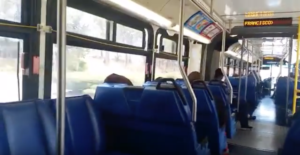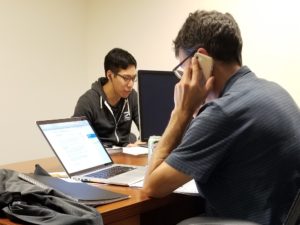After weeks of counting votes for an unprecedented midterm election turnout, it appears that San Mateo’s transportation tax, Measure W, has passed by a razor-thin margin. The measure will generate $80 million per year in sales tax revenue for the next 30 years to improve public transit, create safer bike and pedestrian routes, reduce traffic, repair roads and address other urgent community needs.
This is an enormous victory for the people of San Mateo. And young people and their TEAMC coalition made sure that this victory was possible.

Hundreds of thousands of people rely on San Mateo’s roads and transit systems to get to work, to school, to stores and services, and back home to family. Drawing heavily on community input, the measure will improve environmentally sustainable transportation options in San Mateo County for years to come — especially for those who need it most.
A full 50% of the funds will go to SamTrans, Caltrain, paratransit and other mobility services to better serve low-income communities and communities of color, youth, seniors, people with disabilities, and transit-dependent populations throughout the County. The measure includes:
- Increasing frequencies on some of SamTrans’ core routes and expanded hours of service during mornings, evenings and weekends
- Improving first- and last-mile connections between job centers and transit hubs
- Integrating technology-based solutions that improve efficiency, convenience, access to information and overall rider experience (like WiFi)
Measure W reflects a truly grassroots effort, sourcing key input for the spending plan directly from communities that rely on public transportation. “This measure is the result of a process everyone in San Mateo County can be proud of,” said Fahad Qurashi, YLI’s Senior Program Director. “Our communities raised their voices to share their needs and concerns, and the measure reflects that input. This is a huge step forward for transportation in San Mateo County, and we feel the process can serve as a model for other jurisdictions.” Qurashi played a key role in the year-long collaborative effort between SamTrans and the Transportation Equity Allied Movement Coalition (TEAMC), a coalition of 28 organizations working to amplify the voices of San Mateo’s most vulnerable residents.
Together, TEAMC and SamTrans collected thousands of surveys and hosted community meetings with constituencies throughout the county to help craft the expenditure plan. TEAMC organizers also supported in getting out the vote, phone banking, canvassing at farmers’ markets and Caltrain stations, and campaigning on social media. Over 100 volunteers — including many of our youth leaders — reached tens of thousands of voters in the weeks leading up to the election. These efforts to get out the vote were critical: the Measure, which needed a 2/3 majority, passed by a mere fraction of a percentage point.

Many of our youth were motivated by their personal experiences: “I used to take public transit to work every day,” said Alma Sanchez. “The bus was always full, sometimes they would come too early, and I’d miss them — I’d have to wait 2 hours, until at 8pm, to get on the bus home. There’d always be a fight to get on the bus. There aren’t any shade structures — on rainy days, people would have to wait in the rain.” Cendy Saravia is excited about what’s to come with the passage of Measure W: “It might encourage people like me to actually take the bus. Right now, I’d rather walk than wait for a crowded bus. Having that option will be so much better.”
In addition to improvements in the bus system, the measure includes Caltrain upgrades and improvements to better connect the County to the rest of the region: “We are very pleased to see the strong focus in this measure on transit and active transportation,” said Adina Levin, Executive Director of Friends of Caltrain. “And, in a helpful and innovative move, roadway spending can be used for programs to move more people in fewer cars,” said Levin.
For people who bike and walk, funding will be allocated to fill in the gaps and update facilities for bicycle and pedestrian pathways. “I’m thankful that so much of our San Mateo County community agrees on the need for investing in the transportation system that we all depend on. Investing in transit will make our regional circulation smoother and encourage more people to use alternative modes of transportation — like bikes! — so people can have options to get around with less traffic and stress,” said Emma Schlaes of the Silicon Valley Bicycle Coalition. Sustainable transportation improvements represent at least two-thirds of the funding in the measure.
Finally, the measure includes strong core principles, an independent oversight committee, and a strategic planning process that prioritizes community input to guide spending moving forward..
Looking ahead, TEAMC will be following the strategic planning process and creation of the independent oversight committee to ensure that the full potential of Measure W is realized. “We’re excited to continue partnering with SamTrans and other transit decision-making entities to ensure that community needs and values guide Measure W’s investments moving forward,” said Qurashi.
The win was covered by The SM Daily Journal.
